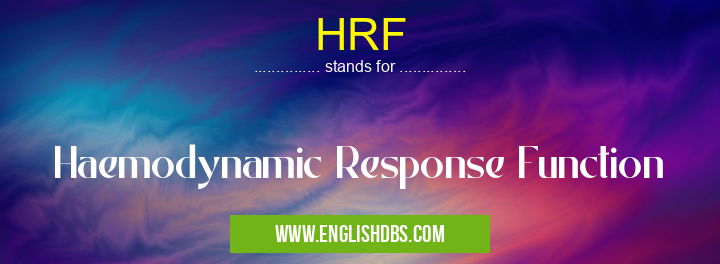What does HRF mean in UNCLASSIFIED
HRF (Haemodynamic Response Function) measures the blood oxygen level-dependent (BOLD) signal's temporal response to neural activity. It quantifies the relationship between neural activity and the corresponding changes in cerebral blood flow, providing insights into neurovascular coupling.

HRF meaning in Unclassified in Miscellaneous
HRF mostly used in an acronym Unclassified in Category Miscellaneous that means Haemodynamic Response Function
Shorthand: HRF,
Full Form: Haemodynamic Response Function
For more information of "Haemodynamic Response Function", see the section below.
Understanding HRF
- BOLD Signal: When neurons fire, they increase their metabolic activity, consuming more oxygen and glucose. This leads to an increase in blood flow to the active area, resulting in a rise in the BOLD signal.
- HRF Shapes: HRF shapes vary depending on physiological factors. They typically consist of an initial positive peak (overshoot), followed by a negative undershoot and a gradual return to baseline.
- Physiological Basis: The overshoot reflects the rapid increase in blood flow to meet the increased metabolic demand. The undershoot represents the subsequent reduction in flow when neural activity subsides. The duration and amplitude of the HRF are influenced by factors such as vascular density, metabolic rate, and neurotransmitter release.
Applications of HRF
HRF analysis is widely used in functional magnetic resonance imaging (fMRI):
- Brain Mapping: By measuring HRF, fMRI can map the spatial distribution of neural activity in response to specific stimuli or tasks.
- Neurological Disorders: HRF abnormalities can provide insights into neurological disorders such as stroke, epilepsy, and neurodegenerative diseases.
- Pharmacological Studies: HRF can assess the effects of drugs and neuroactive substances on neurovascular coupling.
Essential Questions and Answers on Haemodynamic Response Function in "MISCELLANEOUS»UNFILED"
What is the Haemodynamic Response Function (HRF)?
The Haemodynamic Response Function (HRF) is a mathematical model that describes the relationship between neural activity and changes in blood flow and oxygenation in the brain. It represents the temporal dynamics of the neurovascular coupling process, which is the physiological mechanism by which neural activity is translated into measurable changes in brain hemodynamics.
How is the HRF used in functional neuroimaging?
The HRF is used in functional neuroimaging techniques such as fMRI and NIRS to deconvolve the neural activity signal from the measured hemodynamic response. By convolving the estimated HRF with the measured hemodynamic signal, researchers can estimate the underlying neural activity that gave rise to the observed changes in blood flow or oxygenation.
What are the different types of HRFs?
There are various types of HRFs, each representing different aspects of the neurovascular coupling process. Common HRFs include the canonical HRF, the gamma-variate HRF, and the double-gamma HRF. The choice of HRF depends on the specific neurovascular coupling model and the experimental conditions being studied.
How is the HRF estimated?
The HRF can be estimated using various methods, including:
- Model-based methods: These methods assume a specific shape for the HRF and estimate its parameters from the measured hemodynamic data.
- Data-driven methods: These methods use statistical techniques to directly estimate the HRF from the measured hemodynamic data without assuming a specific shape.
What factors can affect the HRF?
The HRF can be influenced by various factors, including:
- Neurophysiological factors: The type and intensity of neural activity
- Vascular factors: The properties of the cerebral vasculature, such as vessel size and density
- Physiological factors: Factors such as age, sex, and physiological state
- Experimental conditions: Factors such as scanner parameters and experimental design
Final Words: HRF is a crucial parameter in fMRI, providing valuable information about neurovascular coupling and brain function. Its analysis enables researchers to understand brain activity patterns and identify potential biomarkers for neurological disorders. As research continues, the application of HRF will further advance our knowledge of brain function and its modulation.
HRF also stands for: |
|
| All stands for HRF |
